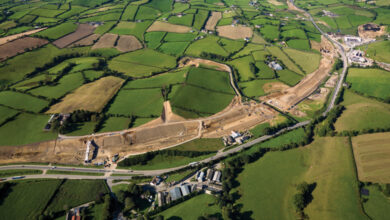Reforming Scottish planning
 Scotland’s planning reform system has streamlined the system’s processes but more improvement is needed in its performance. Chief Planner Jim Mackinnon explained the main changes at agendaNi’s planning seminar.
Scotland’s planning reform system has streamlined the system’s processes but more improvement is needed in its performance. Chief Planner Jim Mackinnon explained the main changes at agendaNi’s planning seminar.
Strong political leadership has led to a simpler, more efficient planning system in Scotland, its outgoing Chief Planner has contended. Addressing an agendaNi seminar, Jim Mackinnon remarked that planning had “more opportunities for public involvement, guaranteed by statute, than any other area of public policy.”
He noted that Northern Ireland faced the extra challenge of devolving planning powers to local authorities. Scotland’s planning authorities are its 32 local authorities and two national park authorities.
Scotland’s second Labour-Lib Dem coalition government (taking office in May 2003) promised to “improve the planning system to strengthen the involvement of local communities, speed up decisions, reflect local views better and allow quicker investment decisions.”
This resulted in the Planning etc. (Scotland) Bill 2006, which passed its first stage with 99 votes to 12 in May 2006. The Bill was enacted in December that year and introduced the most significant changes to the system in sixty years.
It firstly placed the National Planning Framework on a statutory footing. The previous two-tier plan system was dissolved except in the four city regions (Aberdeen, Dundee, Edinburgh and Glasgow), where commuter traffic crosses over council boundaries.
Developments, though, were categorised according to a four-tier planning hierarchy: national; major; local and minor. A choice over the number of airports, for example, would be a national development decision for ministers alone.
“Some environmental groups don’t like it but actually subjecting those sorts of planning decisions to democratic scrutiny is absolutely the way ahead,” he remarked. Major development decisions in Scotland were equivalent to regionally significant developments in Northern Ireland.
Non-controversial local development decisions are delegated to officials, with appeals going to ‘local review bodies’ within councils as opposed to the Minister. Despite the “panic” among officials at first, he found that this had been a “huge success” with councillors “discharging their responsibilities effectively and responsibly.”
One exception exists. A local case can be appealed to a Minister where the official has not decided the application within two months and the local review body has also failed to make a decision within a further two months.
Cultural change had to accompany legislative change. The first steps were set out in ‘Modernising the Planning System: Unlocking Planning’s Potential’ (March 2007) which contained “a lot of warm words, good intentions [and] a sales pitch for planning” but lacked a hard edge.
John Swinney took office as Finance Secretary two months later. The Minister insisted that planning be included in his portfolio and that planning should “make things happen”. He also understood that culture change had to take place in the Scottish Government and its agencies, not just in local authorities.
“And he was very clear. Government agencies were just that,” Mackinnon stated. “They were not environmental pressure groups. They were signed up to the Government’s central purpose of increasing sustainable economic growth.”
Cutting the wording
A concise new guide, ‘Delivering Planning Reform’, was published in November 2008 and also endorsed by professional bodies and the CBI. Written planning policy was cut down from 400 to 60 pages, a task undertaken by one planner in his own staff.
“I think this has been a disturbing trend in planning, where it’s words that get more important than actually place-making and what we want Northern Ireland to be as a place,” he explained.
£12 million was invested in e-planning, to allow people to view applications online at each stage of the process. Most planning decisions are now taken locally and the number of planning cases going to ministers has fallen from 400 to 30: “We might not like some of the decisions they take but they’re taken by local representatives, and that is only right and proper.”
A September 2011 review by Audit Scotland welcomed the leadership shown by Scottish planners and the co-ordination between agencies. The Finance Secretary had encouraged the different parts of the system to be more proportionate and find more positive solutions, where possible.
“Now there will be situations where there is no positive solution. It has to be ‘no’. That’s understandable but can we just say ‘no’ quickly and get on with it?” Extra information and analysis does not help when the decision is likely to be negative.
That said, the review found little improvement in performance despite the reduced number of applications. A comprehensive performance framework was needed and the gap between income and expenditure was widening.
Scotland’s top-level planning fee is £60,000, compared to £250,000 elsewhere in the UK. Under a ‘sunset clause’ proposed since then, a council will be able to charge up to £100,000 but this will drop to £60,000 again if performance did not improve.
The Scottish Government set out four priorities for reform in March:
1. promoting a plan-led system;
2. driving improved performance;
3. simplifying and streamlining processes; and
4. delivering development.
This year, the Government will review the National Planning Framework, to focus on economic recovery and increase support for renewable energy. In 2013, it will review the strategic development plans for city regions; it is unclear whether these are adding value to the system.
Local development plans will also come under scrutiny: “A lot of these plans almost could be anywhere. They are not really about place.” Wording was still a problem and customers had to read through several documents to find out what they could do with their property.
Stakeholder engagement had to go beyond communities (a “much used and much abused” word) and involve listening to private sector in a better way, to identify economic opportunities.
Simplifying and streamlining the system would involve reducing the number and cost of appraisals. ‘Processing agreements’ would commit private sector applicants to submitting correct information on time, and he wanted to see more ‘one-stop shops’ for heritage consents and roads projects.
In summary, Scotland had retained its political consensus on planning but was determined to remove processes that added no value. Enthusiastic and committed young planners, he noted, wanted to make a difference and needed to be “liberated from the day-to-day grind.”
And planners needed to zoom out from individual applications to see the wider picture: “It’s not about buildings, it’s about spaces and I think as a built environment profession, we need to rise more effectively to that challenge.”





